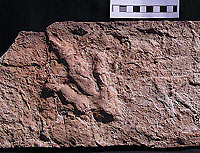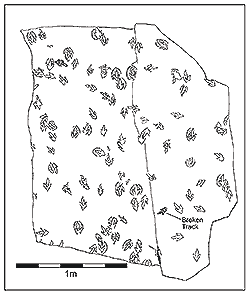PALEO HAPPENINGS May 2020 |
|||||||||
| by Martin Lockley, Moab Giants by Martin Lockley, Moab Giants |
|||||||||
Dinosaurs were big - right? Last month we introduced Eubrontes (meaning ‘true thunder’) the 12-15 inch-long tracks of a large carnivore, up 15-16 feet long. We only briefly mentioned small bird-like, three-toed tracks, 3-6 inches long. These tracks, named back in the 1850s as Grallator (meaning ‘stilt walker’), were thought to represent long-legged wading birds, like storks or herons. Actually some were only 2 inches (5 cm) long, so not that big- right? A track 2-3 inches long, was crow or raven sized, indicating a leg about 9 inches long and a body perhaps two feet long, much of that neck and tail. So not only was our dinosaur small, and bird like, but in the 1850s people called them Noah’s Raven tracks. If we ask “which are the oldest known dinosaur tracks?” the answer is: this type - Grallator, dating from the Late Triassic epoch (age 200-235 million years). When first found in the 1850s small carnivorous dinosaurs (theropods) were not known, so it was assumed the tracks were those of ancient birds. Later theropods became known, and Noah’s Raven tracks became those of dinosaurs. But then, a reversal of scientific opinion: paleontologists discovered that birds evolved from theropod dinosaurs. So the Grallator track makers were bird ancestors all along. Put another way today’s raven or turkey is a living theropod dinosaur. In each of the three toes, equivalent to our 2nd, 3rd and 4th, most theropods and birds have 2, 3 and 4 toe bones. Easy-to-remember Anatomy 101: 2-3-4 = 2-3-4.
So what does this evolutionary story mean? First, the earliest dinosaurs were small, carnivorous, and bipedal, like birds. As larger and quite different dinosaurs evolved (e.g., sauropods, stegosaurs, horned dinosaurs etc.,) the makers of Grallator tracks remained abundant. So the small bipedal bird-like design continued to evolve and prove successful. Big theropods like Allosaurus and T. rex were rare and sooner or later died out. So, small was beautiful. This pattern also applies to us mammals. The early species, also from the Late Triassic, were small. Large species evolved much later: in fact, after the big dinosaurs died out at the end of “the Age of Dinosaurs” 65 million year ago. And what survived? Small mammals and birds, thus beginning the “Age of Mammals and Birds.” Likewise early primates (pre-monkeys) were small. Humans and Great Apes are large.
|
|||||||||


